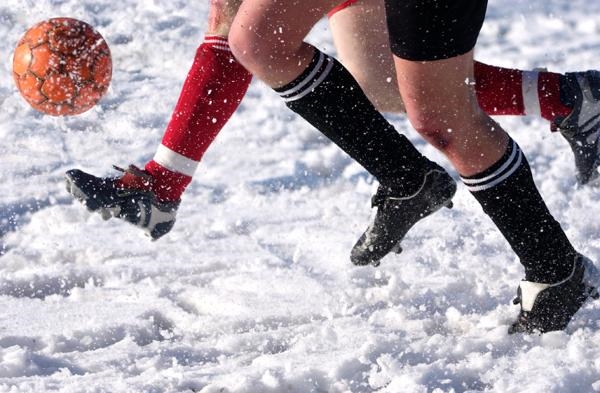
We collect basic website visitor information on this website and store it in cookies. We also utilize Google Analytics to track page view information to assist us in improving our website.
If you want to play soccer during the winter, you’re forced to play it indoors. Or are you? While indoor soccer is the best way to play a traditional game of soccer, a little bit of outdoor winter soccer is a fun way to mix up the game.
Now don’t get us wrong, as a company that specializes in creating indoor sport facilities that are perfect for soccer, we’re not saying playing outside in the snow is a good replacement. After all, the cold can be uncomfortable, not to mention the risk for slipping or hurting yourself. No, winter soccer probably isn’t the way to enjoy a traditional game, but if you’re looking for a fun way to cool down after a practice, or have a few minutes to kill before you can get inside, here are 5 tips to getting a game of winter soccer going.
 |
Wear Your Cleats
Snow is slippery! Keep your soccer cleats on to be able to dig in and avoid slip sliding around the pitch. Soccer cleats don’t provide much insulation, though, so be aware of your toes and don’t let them get too cold!
Don’t Use a White Ball
While a white ball is great for visibility on a green field, it’ll get lost pretty quickly amongst white snow. Couple this with how reflective snow is in the sun, and you’ll have a hard time picking out the ball.
A dark coloured ball will be that much more visible to help you avoid taking an accidental header during the match.
Play on a Smaller Field
You won’t be able to build up as much speed or put as much power into your kicks, so it’s probably a good idea to reduce the size of your playing area. Half or even a quarter of a pitch is likely to be enough for a short fast paced game of snow soccer!
Limit your time Playing
Doing anything outside in sub-zero temperatures can be dangerous. Running around and getting sweaty can be especially dangerous as the sweat will make your body cool down too quickly, putting you into a danger zone for hypothermia.
To avoid this, set a short playing time that makes sense for the temperature. If it’s really cold, a 5-minute game might be all that is safe.
Know when to Move Indoors
As noted in the previous point, you’re likely going to get pretty warm fairly quickly. This means you’ll be feeling good and having fun, but always be ready to move the game back inside. While you might feel nice and warm, your extremities might be getting cold without you realizing. Frost bite in your fingers or toes are a very real danger so be ready to get back inside quickly.
Any tingling or loss of feeling is a warning sign to move that soccer game back indoors so be ready to duck back into that soccer dome!
While playing in a heated, indoor soccer facility might be the best way to play soccer in the winter, a short game in the snow can be fun as well. The thing to remember is to be careful and be outdoors in moderation. And always be ready to bring that game back into your soccer dome!
